
Zermatt is a municipality in the district of Visp in the German-speaking section of the canton of Valais in Switzerland. It has a year-round population of about 5,800 and is classified as a town by the Swiss Federal Statistical Office (FSO).

The Schynige Platte Railway is a mountain railway in the Bernese Highlands area of Switzerland, which connects the town of Wilderswil, near Interlaken, with the famous wildflower gardens of the Schynige Platte.

The Gornergrat Railway is a mountain rack railway, located in the Swiss canton of Valais. It links the resort village of Zermatt, situated at 1,604 m (5,262 ft) above mean sea level, to the summit of the Gornergrat. The Gornergrat railway station is situated at an altitude of 3,089 m (10,135 ft), which makes the Gornergrat Railway the second highest railway in Europe after the Jungfrau, and the highest open-air railway of the continent. The line opened in 1898, and was the first electric rack railway to be built in Switzerland. The Gornergrat is a starting point for many hikes, as it lies surrounded by 29 peaks rising above 4,000 m (13,123 ft) in the Alps and several glaciers, including the Gorner Glacier. At the end of the line on Gornergrat, the Matterhorn is visible on a clear day. It is also a popular skiing area.

The Gornergrat is a rocky ridge of the Pennine Alps, overlooking the Gorner Glacier south-east of Zermatt in Switzerland. It can be reached from Zermatt by the Gornergrat rack railway (GGB), the highest open-air railway in Europe. Between the Gornergrat railway station and the summit is the Kulm Hotel. In the late 1960s two astronomical observatories were installed in the two towers of the Kulmhotel Gornergrat. The project “Stellarium Gornergrat” is hosted in the Gornergrat South Observatory.

Riffelberg is a railway station on the Gornergrat railway, a rack railway which links the resort of Zermatt with the summit of the Gornergrat. The station is situated west of the Gornergrat, in the Swiss municipality of Zermatt and canton of Valais, at an altitude of 2,582 m (8,471 ft) above mean sea level. It is the third highest station on the line and, considering only open-air railway stations, the third highest in Switzerland and Europe as well.

Riffelalp is a hamlet in the municipality of Zermatt in the canton of Valais. It is located at a height of 2,222 metres (7,290 ft) above sea level, just above the tree line, approximately halfway between the town of Zermatt and the Gornergrat mountain. Once the site of the prestigious Riffelalp Grand Hotel, today Riffelalp mainly consists of a large hotel complex, the Riffelalp Resort 2222m, and a chapel.

Zermatt railway station is a metre gauge railway station serving the car-free mountaineering and ski resort of Zermatt, in the Canton of Valais, Switzerland. It is the southern terminus of the BVZ Zermatt-Bahn (BVZ), which connects Zermatt with standard gauge lines at Visp and Brig. Since 1 January 2003, the BVZ has been owned and operated by the Matterhorn Gotthard Bahn (MGB), following a merger between the BVZ and the Furka Oberalp Bahn (FO). The station is across the street from Zermatt GGB railway station, the valley terminus of the Gornergrat Railway.

The Aachen tramway network was the backbone of public transport in Aachen, now in the federal state of North Rhine-Westphalia, Germany, and the surrounding areas from 1880 to 1974. The track gauge was 1,000 mm, see Nordrhein-Westfalen.

The Nordhausen tramway is a network of tramways forming part of the public transport system in Nordhausen, a city in Thuringia, Germany.

Gornergrat is the upper terminal railway station of the Gornergrat railway, a rack railway which links it with the resort of Zermatt. The station is situated at the summit of the Gornergrat, in the Swiss municipality of Zermatt and canton of Valais. At an altitude of 3,089 m (10,135 ft) above mean sea level, it is the highest open-air railway station in Europe.

Trams in Linz is a network of tramways forming the backbone of the urban public transport system in Linz, which is the capital city of the federal state of Upper Austria in Austria.

Riffelalp is a railway station on the Gornergrat railway, a rack railway which links the resort of Zermatt with the summit of the Gornergrat. The station is situated west of the Gornergrat, in the Swiss municipality of Zermatt and canton of Valais, at an altitude of 2,211 m (7,254 ft) above mean sea level.

The Meiringen–Reichenbach–Aareschlucht tramway was a metre gauge electric tramway in the Swiss canton of Bern. It linked the town of Meiringen with the tourist attractions of the Reichenbach Falls, where it served the lower station of the Reichenbachfall Funicular, and the Aare Gorge, where it served the gorge's western entrance.

The Rigi–Scheidegg railway is a former railway line built high on the Rigi massif on the cantonal border between Lucerne and Schwyz in Switzerland. Today the line's trackbed, which is 6.7 kilometres (4 mi) in length, and includes a 70-metre (230 ft) tunnel and several bridges, is a rail trail, which serves as a panoramic footpath in summer, and as a route for cross-country skiing in winter.

The Arth–Rigi railway line is a Swiss standard gauge rack railway that runs from Arth-Goldau RB to Rigi. It was built by the eponymous Arth-Rigi-Bahn between 1873–1875 and operated by that company until its merger with the Vitznau-Rigi-Bahn in 1992 to form Rigi Railways.

The Biel–Täuffelen–Ins railway line is a railway line in Switzerland that runs from Biel/Bienne to Ins along the east side of the Lake Biel. The line is owned and operated by Aare Seeland mobil (ASm).

The Langenthal-Jura Railway was a former railway company in Switzerland. It merged in 1958 with the Langenthal–Melchnau-Bahn to form Oberaargau-Jura Railways, which then operated the then still 11 km-long, metre-gauge LJB line from Langenthal to Niederbipp. After further mergers, the Langenthal–Oensingen railway line has been part of the Aare Seeland mobil (ASm) since 1999.

The He 2/2 51 to 58 of the Wengernalp Railway, abbreviated WAB, are electric rack railway locomotive for 1500 volt direct current and a track gauge of 800 mm. They were built in 1909 and 1910 on the occasion of the electrification of the railway lines Lauterbrunnen–Wengernalp–Kleine Scheidegg as well as Grindelwald–Grindelwald Grund–Kleine Scheidegg and served as a model for the largely identical locomotives that were subsequently procured He 2/2 59 to 63.
























